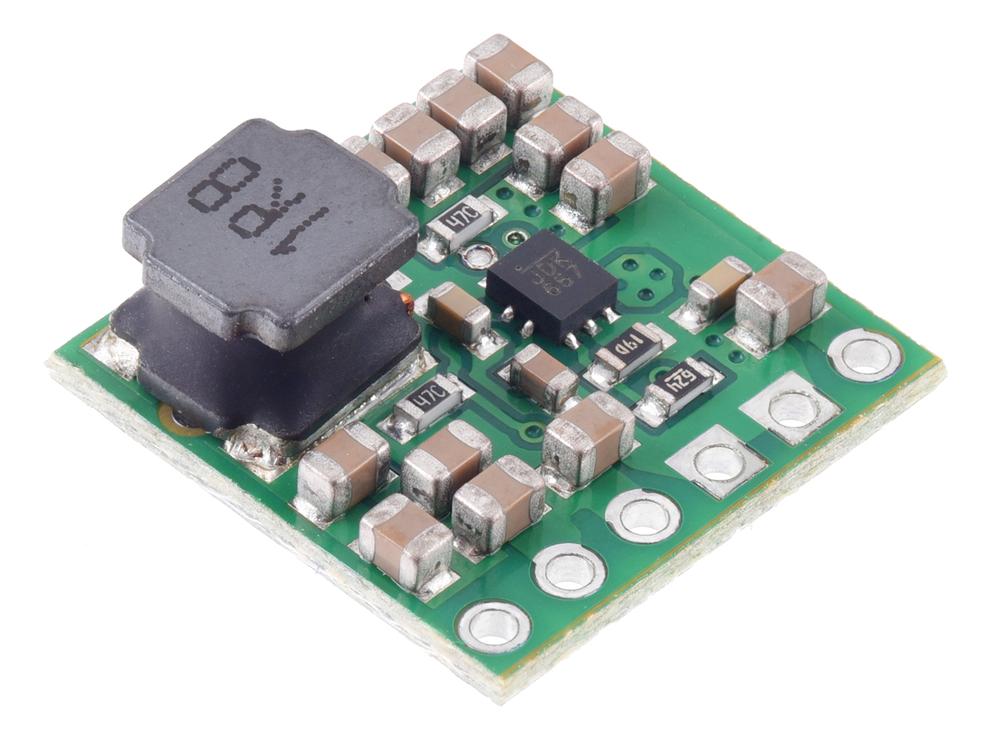Pololu 5V Step-Up Voltage Regulator U3V40F5

Description
This compact (0.6″×0.6″) switching step-up (or boost) voltage regulator efficiently generates 5 V from input voltages as low as 1.3 V and handles continuous input currents up to around 4 A. (Note: minimum start-up voltage is 2.7 V, but it operates down to 1.3 V after that.) The pins have a 0.1″ spacing, making this board compatible with standard solderless breadboards and perfboards.
The U3V40Fx family of boost (step-up) voltage regulators are high-efficiency synchronous switching regulators that generate higher output voltages from input voltages as low as 1.3 V. (Note: minimum start-up voltage is 2.7 V; see the connections section for details.) The regulators actively limit the instantaneous input currents to 9.5 A, and the input current can typically be as high as 4.5 A for several seconds before the thermal protection activates. Input currents of around 3.5 A can typically be maintained for many minutes without triggering thermal shutdown, though the actual performance depends on the input and output voltages as well as external factors such as ambient temperature and airflow. For boost regulators, the output current equals the input current times the efficiency divided by the boost ratio of VOUT to VIN, so the more you are boosting, the lower the maximum output current will be (see the maximum continuous output current section below for performance graphs).
These regulators feature a variety of built-in protections, including cycle-by-cycle input current limiting, soft-start, programmable under-voltage lockout, output over-voltage protection, and over-temperature shutdown.
Warning: This boost regulator uses the typical topology that connects the input to the output through an inductor and diode, with nothing to completely break that current path. Therefore, the input voltage will go through to the output even when the regulator is disabled, and exposure to short circuits or other excessive loads will damage the regulator.
Properties
| Brand | Pololu |
| Model | 4012 |
| Position | Voltage regulator |
| Chip | U3V40F5 |
Delivered in 5 to 14 days Shipped from € 3,50 (NL) 30 days cooling-off Excellent service
Alternative products
Customer questions
Customer Reviews
- In stock Pololu 3.3V Step-Up Voltage Regulator U1V10F3 € 6,- View product
- In stock Pololu 5V, 500mA Step-Down Voltage Regulator D24V5F5 € 7,60 View product
- In stock Pololu Mini Pushbutton Power Switch with Reverse Voltage Protection, LV € 4,50 View product
- In stock Pololu QTR-8A Reflectance Sensor Array € 11,- View product
- In stock Pololu 3.3V Step-Up Voltage Regulator U1V11F3 € 6,80 View product
- In stock Pololu Mini MOSFET Slide Switch with Reverse Voltage Protection, LV € 4,10 View product
- In stock Pololu Mini Slide Switch: 3-Pin, SPDT, 0.3A (3-Pack) € 2,45 View product
- In stock Pololu 5V, 1.5A Step-Up/Step-Down Voltage Regulator S13V15F5 € 10,60 View product
- In stock Pololu 400-Point Breadboard with Mounting Holes € 4,50 View product
- In stock Pololu Servo Extension Cable 12" Male - Female € 4,25 View product
- In stock Pololu Brushed DC Motor: 130-Size, 6V, 11.5kRPM, 800mA Stall € 2,90 View product
- In stock Pololu Step-Up/Step-Down Voltage Regulator S7V7F5 € 7,20 View product
- 25 pieces In stock Pololu 0.1" (2.54mm) Crimp Connector Housing: 1x2-Pin 25-Pack € 2,35 View product
- In stock Pololu Stranded Wire: Red, 20 AWG, 40 Feet € 11,15 View product
- 25 pieces In stock Pololu Nylon Spacer: 10mm Length, 5mm OD, 3.3mm ID (25-Pack) € 2,65 View product









